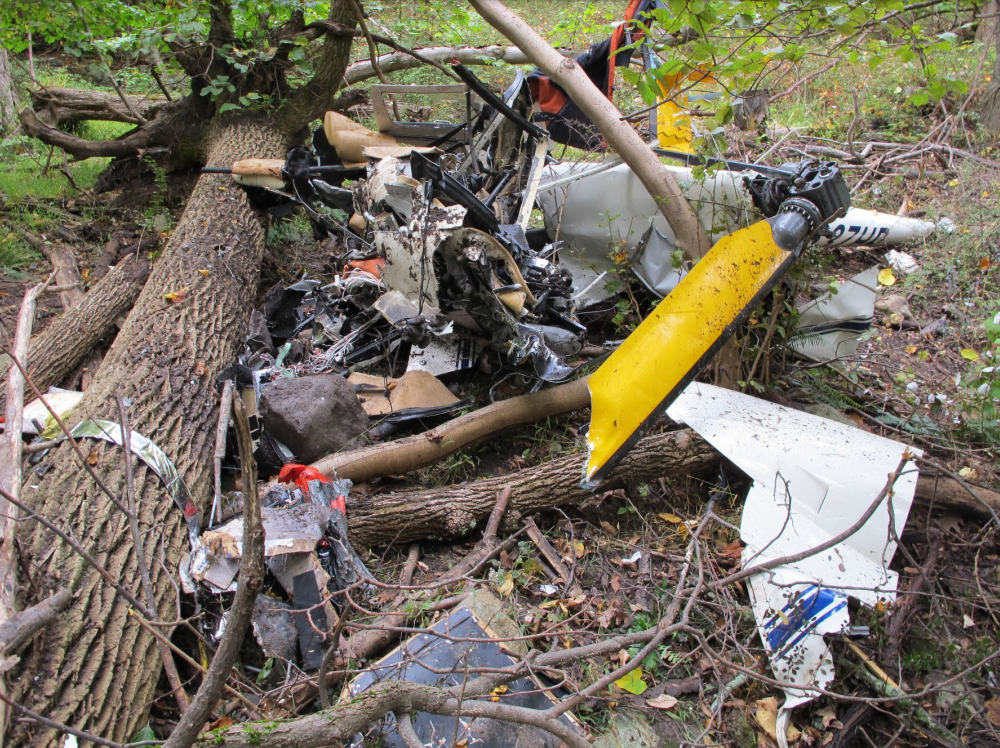
ASN Wikibase Occurrence # 268467
This information is added by users of ASN. Neither ASN nor the Flight Safety Foundation are responsible for the completeness or correctness of this information.
If you feel this information is incomplete or incorrect, you can submit corrected information.
| Date: | Sunday 10 October 2021 |
| Time: | 13:57 |
| Type: |  Robinson R44 Raven II |
| Owner/operator: | SMT Ops Inc |
| Registration: | N637HP |
| MSN: | 11942 |
| Year of manufacture: | 2007 |
| Total airframe hrs: | 867 hours |
| Engine model: | Lycoming IO-540-AE1A5 |
| Fatalities: | Fatalities: 1 / Occupants: 1 |
| Aircraft damage: | Destroyed |
| Category: | Accident |
| Location: | Storm King Mountain, near Cornwall, NY -
 United States of America United States of America
|
| Phase: | En route |
| Nature: | Private |
| Departure airport: | Glenn Falls-Floyd Bennett Memorial Airport, NY (GFL/KGFL) |
| Islip-Long Island MacArthur Airport, NY (ISP/KISP) | |
| Investigating agency: | NTSB |
| Confidence Rating: |
On October 10, 2021, at 1357 eastern daylight time, a Robinson R44 II, N637HP, was destroyed when it was involved in an accident in Cornwall, New York. The pilot was fatally injured. The helicopter was operated as a Title 14 Code of Federal Regulations Part 91 personal flight.
The non-instrument-rated helicopter pilot was returning to his home airport as the height of the overcast ceiling gradually decreased along the route of flight, consistent with the forecast conditions. While flying along the river valley at an altitude of 1,800 to 1,900 ft above mean sea level (100 to 200 ft below the clouds), the helicopter flew beneath an area of light-intensity precipitation echoes as detected by weather surveillance radar. It is likely that, at this time, the pilot encountered reduced visibility in very light rain and potential clouds. About the same time, the helicopter began to climb, and its groundspeed decreased. Shortly after climbing above the altitude of the reported cloud ceiling, the helicopter entered a relatively constant-rate turn. About 9 seconds later, the track straightened for about 3 seconds, the climb rate plateaued at about 2,400 feet per minute, and the groundspeed began to increase. The helicopter continued to climb for another 10 seconds as the groundspeed increased to about 95 knots. During this time, it again turned toward the right for about 9 seconds. Just before the end of the turn, the helicopter began to descend rapidly. As it descended through the altitude of the cloud ceiling, the rate of descent reached 16,200 feet per minute. The tracking data ended about 2 seconds later in the vicinity of the accident site.
Postaccident examination of the airframe revealed no preimpact anomalies that would have precluded normal operation. Damage and fragmentation to the main and tail rotor blades, along with score marks on a frame tube near the tail rotor drive intermediate coupling, were consistent with rotor system rotation during the impact sequence. Impact marks found on the upper drive sheave and dents found on two of the engine's cooling fan blades were consistent with the engine's crankshaft not rotating at the time of impact. The drive sheave mark was an imprint with an outline of teeth from starter ring gear, which was mounted on the engine crankshaft. The imprint, (rather than scoring or cut grooves) was consistent with the engine's crankshaft was not rotating when it contacted the sheave. Similarly, the dents on the cooling fan blades, each found directly below airframe components that likely caused the dents, suggest the cooling fan was not rotating when its blades made contact during impact. Also, the fuel servo mixture arm was found bent and in the idle-cutoff (no fuel to engine) position. The mixture cable sheathing was found stretched in several locations, consistent with tension. Tension on the cable, and other impact forces, likely pulled the mixture arm toward the idle-cutoff position. Despite these findings, no evidence of any preimpact mechanical malfunctions or failures of the engine were discovered that would have precluded normal engine operation. The flight track information, which showed a simultaneous climb and increase in groundspeed before the accident, was consistent with the engine providing power; therefore, it is likely that the crankshaft stopped during the impact sequence before the helicopter came to rest.
The pilot's continued visual flight rules flight into an area of instrument meteorological conditions due to clouds and precipitation likely resulted in his loss of outside visual references, an environment conducive to the development of spatial disorientation, and the helicopter's flight track was consistent with the known effects of spatial disorientation. According to the pilot's logbook, he had not received any instrument training, nor was the helicopter certified for flight in instrument conditions. These factors increased the likelihood of the pilot becoming spatially disoriented after encountering reduced visibility conditions.
Probable Cause: The non-instrument-rated pilot's continued flight into deteriorating weather conditions, which resulted in a loss of control due to spatial disorientation.
Accident investigation:
 |
|
Sources:
NTSB ERA22FA010
https://data.ntsb.gov/Docket?ProjectID=104078
FAA register: https://registry.faa.gov/aircraftinquiry/Search/NNumberResult?NNumberTxt=637HP
Location
Images:

Photo: NTSB
Revision history:
| Date/time | Contributor | Updates |
|---|---|---|
| 10-Oct-2021 21:56 | Geno | Added |
| 11-Oct-2021 00:32 | Captain Adam | Updated [Aircraft type, Location, Embed code] |
| 11-Oct-2021 03:17 | RobertMB | Updated [Registration, Cn, Operator, Phase, Nature, Departure airport, Destination airport, Source, Embed code, Damage, Narrative] |
| 12-Oct-2021 11:04 | Captain Adam | Updated [Narrative] |
| 22-Dec-2023 11:25 | ASN Update Bot | Updated [Time, Operator, Other fatalities, Departure airport, Destination airport, Source, Narrative, Category, Accident report] |
| 22-Dec-2023 11:26 | harro | Updated [Operator, Other fatalities, Source, Narrative] |
| 22-Dec-2023 12:17 | Captain Adam | Updated [Time, Operator, Location, Source, Narrative, Photo] |
Corrections or additions? ... Edit this accident description
The Aviation Safety Network is an exclusive service provided by:


 ©2024 Flight Safety Foundation
©2024 Flight Safety Foundation